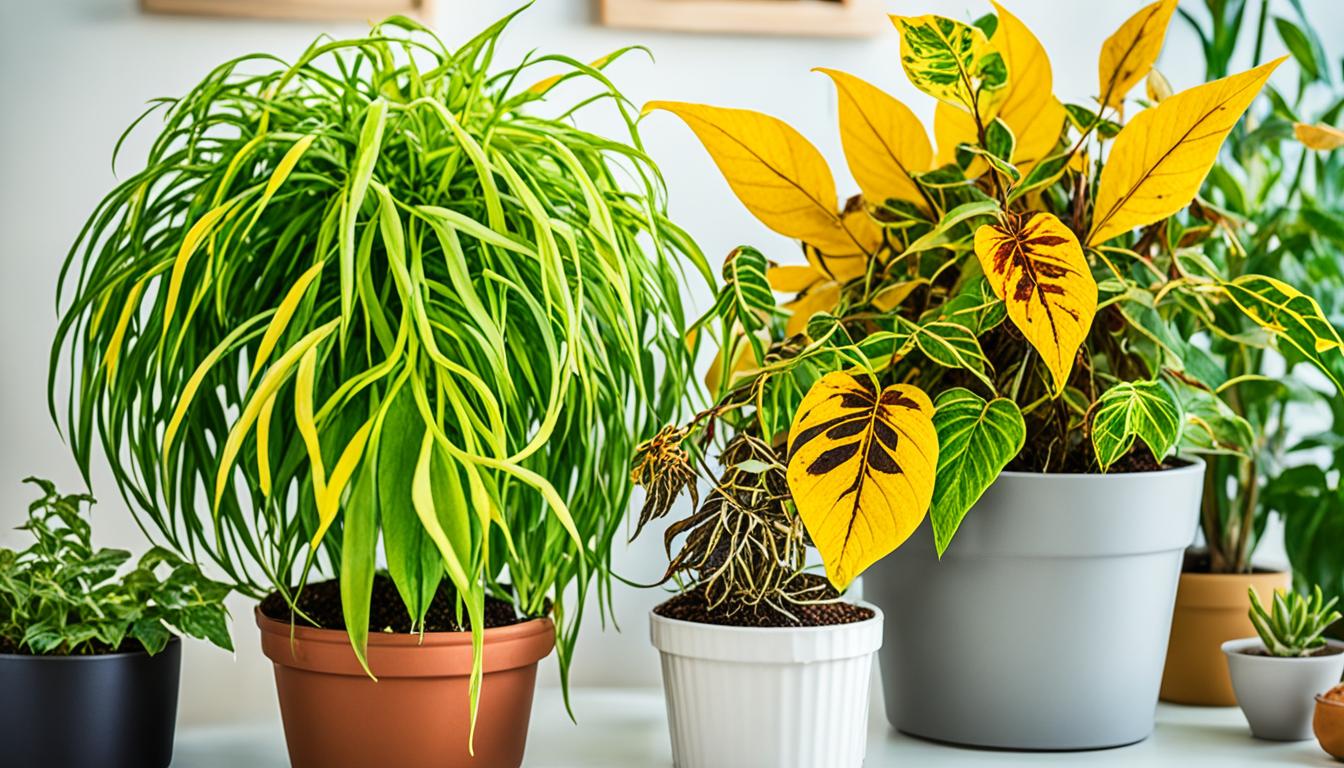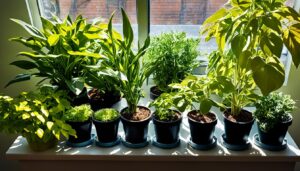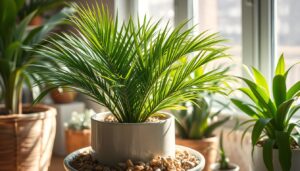Are your indoor plants not doing well, and you don’t know why? This guide will show you how to fix common indoor plant issues. You’ll learn to spot and solve problems like yellow leaves, slow growth, and droopy stems. It’s all about keeping your indoor garden healthy and bright.
This guide is for everyone, from beginners to experienced plant lovers. It covers issues like yellow leaves, dropping leaves, and more. With advice from plant experts, you’ll know how to make your indoor plants flourish.
Let’s start solving common indoor plant problems together. With this guide, you’ll create a beautiful indoor space that makes your home feel peaceful and welcoming.
Introduction
Dealing with indoor plant care issues can be tough. But knowing the signs of unhealthy plants helps keep your indoor garden thriving. This guide will teach you how to spot and fix common houseplant problems.
We’ll cover how to understand the causes and find solutions. Our plant experts at the shops and garden centers are ready to help too. Just show us a photo of your plant, and we’ll find the best way to fix it.
The key to successful indoor plant care is being able to recognize the early warning signs and address them proactively.
Learning the basics of indoor plant care leads to a lush, vibrant indoor space. Let’s look at common issues and how to solve them.
Yellowing Leaves
Causes and Solutions
If your indoor plants have yellow leaves, it’s key to find out why quickly. Yellowing can happen for many reasons, like watering mistakes or pests. Knowing the cause helps you fix your plants and bring back their healthy look.
Overwatering is a common reason for yellow leaves. When plants get too much water, the lower leaves turn yellow first. Fix this by changing how often you water and making sure the soil drains well. On the other hand, not watering enough can also cause yellowing, especially in new growth. Make sure your plants get the right amount of moisture.
Not enough or too much sunlight can also make leaves turn yellow. Too much sun can burn the leaves and turn them yellow. Not enough light makes new growth look pale and unhealthy. Try moving your plants to a spot with better lighting.
Pests like thrips or spider mites can also cause yellow leaves. Check your plants for these pests and treat them with sprays or organic solutions if you find them.
Sometimes, plants naturally shed leaves as they get older, which can make some leaves turn yellow. This is normal and usually not a problem. But if a lot of leaves are turning yellow, you should look into it more.
Fixing the reasons behind yellow leaves, like watering, light, pests, or lack of nutrients, can help your plants stay healthy and colorful.
https://www.youtube.com/watch?v=BopuNFAhfrs
Dropping Leaves
If your indoor plants are losing leaves, it might mean they’re experiencing plant shock symptoms or stress. A sudden change in their environment, like moving or changes in temperature or light, can cause overwatered plant dropping leaves. These houseplant stress reactions help the plant survive by dropping leaves.
Ficus and other sensitive plants may drop leaves if they don’t like sudden changes. Overwatering, which can lead to root rot, is another reason for losing leaves. The plant tries to save resources by dropping leaves. To prevent this, watch how much you water and slowly adjust your plant to new conditions.
“When a plant is stressed, it will often shed leaves as a way to conserve resources and focus on survival.”
To fix indoor plants losing leaves, check their growing conditions first. Make sure the soil isn’t too wet and adjust your watering. Slowly get your plant used to changes in light, temperature, or location to prevent plant shock symptoms. With the right care, your plant should start growing healthy again.
| Cause | Symptom | Solution |
|---|---|---|
| Overwatering | Overwatered plant dropping leaves | Adjust watering frequency and ensure proper drainage |
| Environmental stress | Indoor plants losing leaves | Gradually acclimate the plant to changes in light, temperature, or location |
| Root rot | Houseplant stress reactions | Improve soil drainage and monitor watering closely |
Understanding why indoor plants losing leaves happens can help you fix the issue. By taking the right steps, you can help your plants do well indoors.
Discolored Leaf Tips or Edges
If you’ve seen your indoor plants’ leaves turning discolored at the tips or edges, it might signal a problem. Issues like low humidity or mineral buildup could be the cause. Knowing what’s wrong and fixing it quickly can save your houseplants.
Addressing the Issue
“Indoor plant leaves curling” often happens because of low humidity. To fix this, mist your plants often, use a pebble tray, or put them close together. This raises the humidity and stops “brown leaf tips houseplants” from happening.
“Houseplant nutrient deficiencies” can also cause discolored tips. These come from too many salts and minerals in the soil. Try flushing the soil with water to clear out the salts. Don’t fertilize when your plant is dormant, as it can make things worse.
If your plant has “reviving plants with salt buildup”, consider repotting it in fresh, well-draining soil. This will help with “improving humidity for indoor plants” and boost its health.
Sometimes, fungal diseases cause leaf curling or tip damage. If you think this is the case, use a neem oil fungicide to treat your plant.
“Pay close attention to your indoor plants’ leaves, as discoloration or edge damage can provide valuable insights into their needs.”
Fixing the reasons behind discolored leaf tips or edges can help your indoor plants stay healthy and look great.
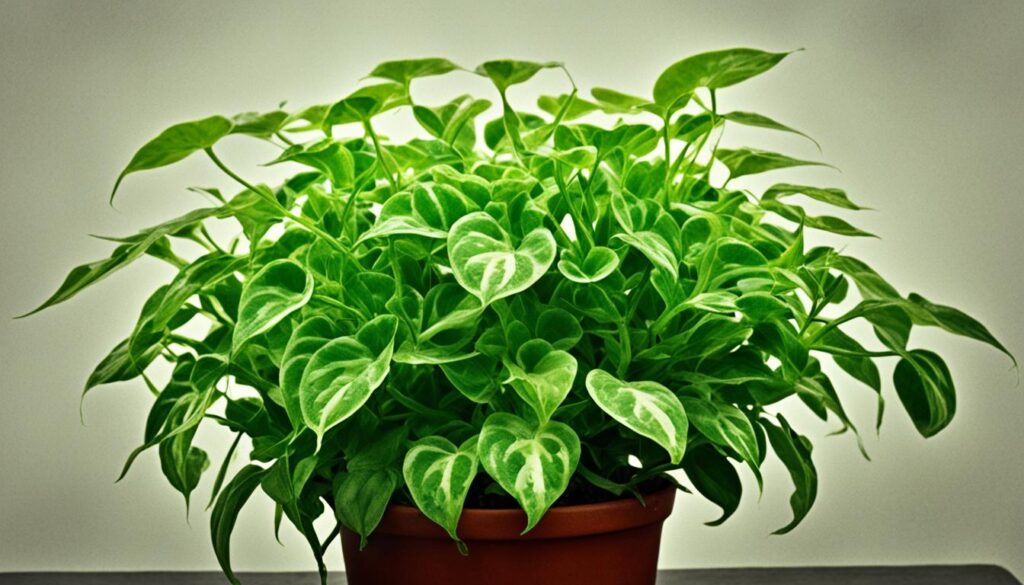
Distorted or Misshapen Growth
If your indoor plants have leaves that look odd or misshapen, it’s key to find out why. This problem might mean pests, fungal diseases, or stress from the environment.
Thrips, aphids, or other tiny bugs can make indoor plant leaves deformed. They eat on the leaves, causing them to curl or twist. Look for these pests that cause leaf distortion on your plants. Use insecticidal soap or neem oil to get rid of them.
Fungal diseases can also mess with houseplant growth problems. Things like powdery mildew or root rot can make leaves grow wrong. Make sure your plants get enough light and air. Use neem oil-based fungicide if you find fungal problems.
Too dry or packed soil can also cause leaves to curl or grow wrong. Check the soil and water your plants right to keep them healthy.
Watch your plants closely and fix any problems you find. This way, they can grow healthy again. Stay alert and act fast to keep your indoor plants doing well.
common indoor plant problems
Indoor plants can be a fun journey, but they come with challenges. Issues like yellow leaves and distorted growth are common. Knowing these problems and their causes helps you fix them and keep your plants healthy.
Identifying and Addressing Leaf Discoloration
Yellow leaves and discolored tips or edges are common. They can come from overwatering, underwatering, not enough light, or not enough nutrients. By looking at the leaves and the plant’s health, you can find the cause and fix it.
Tackling Leaf Drop and Distorted Growth
Leaf drop and misshapen growth can be tough, but they tell you something. Sudden leaf drop means stress, while distorted growth means light, temperature, or pests issues. Fixing these problems quickly helps your plants stay healthy and look great.
| Common Houseplant Issue | Potential Causes | Recommended Solutions |
|---|---|---|
| Yellowing Leaves |
|
|
| Dropping Leaves |
|
|
| Distorted or Misshapen Growth |
|
|
Knowing the common houseplant issues helps you fix indoor plants. By spotting symptoms and solving the cause, you keep your houseplants thriving. This way, you can enjoy the beauty of your indoor plants.
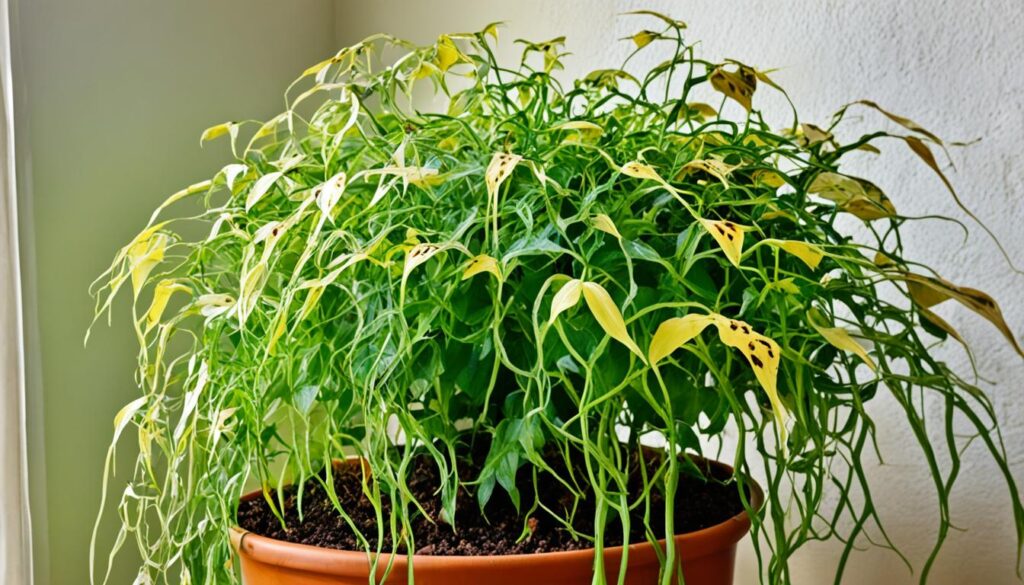
“The key to a healthy, happy indoor plant is understanding its unique needs and responding to potential issues promptly.”
Weak, Spindly Growth and Tiny Flying Bugs
If your indoor plants look weak and have spindly stems, they might not get enough light. Without enough sunlight, plants stretch and grow lopsided. To help a “dying” houseplant, move it to a brighter spot or use plant grow lights.
Tiny flying bugs like fungus gnats can also cause problems. These pests love damp soil and harm plants by eating their roots. To stop them, let the soil dry out between waterings. Also, consider repotting your plant in fresh, well-draining soil.
Identifying and Resolving the Issues
To figure out why your plant is struggling, check its leaves, stems, and soil for pests or diseases. Look for leaves that are discolored or look odd, and watch for tiny flying bugs. If you think it’s a lighting issue, turn the plant to get even light or move it to a brighter spot.
- Make sure the plant gets enough sunlight or extra light.
- Look for pests like fungus gnats and deal with them.
- Repot the plant in fresh, well-draining soil to stop pests.
- Watch the plant and adjust things as needed to help it grow.
By fixing the issues of weak growth and pests, you can revive your indoor plants. They will look vibrant and healthy again.
Sticky or Shiny Residue
Have you seen a sticky or shiny stuff on your indoor plants? It might mean you have pests like mealybugs, scale, and aphids. These bugs eat the sap of your plants, leaving behind a sticky mark.
Check your plants carefully, especially the underside of leaves and where leaves meet stems. Look for bugs with a waxy coating or tiny bugs moving around.
After finding the pests, clean the leaves with insecticidal soap or neem oil. This will get rid of the pests and stop them from spreading. Watch the plant closely and keep it away from other plants until it’s pest-free.
| Pest | Appearance | Damage |
|---|---|---|
| Mealybugs | Small, white, cotton-like insects | Suck sap, cause sticky residue, distorted growth |
| Scale | Small, hard, brown or white insects | Suck sap, cause shiny, sticky leaves |
| Aphids | Small, pear-shaped, green or black insects | Suck sap, cause sticky leaves on indoor plants |
By being careful and acting fast, you can spot and deal with mealy bugs, scale, and aphids. This will help keep your indoor plants healthy and looking great.
Environmental Stress
Keeping the right environment is key for your houseplants’ health. Factors like wrong watering, too much light or heat, and low humidity can stress them out. If you see signs of an overwatered plant or symptoms of an underwatered houseplant, check your plant’s environment.
Factors and Mitigation
Water imbalance is a big stress for indoor plants. Overwatering can cause yellow leaves, wilting, and root rot. On the other hand, underwatering leads to dry, crispy leaves and slow growth. Make sure to water your plants right and use proper drainage.
Too much sunlight or heat can make indoor plants sunburn. This leads to discolored, shriveled leaves. Move your plants to a spot with better lighting and temperature.
Low humidity can also harm houseplants, making leaves turn brown at the tips or edges. To fix this, mist your plants often, use a pebble tray, or get a humidifier.
Salts and minerals in the soil, and lacking nutrients, can stress plants too. Reviving plants with nutrient deficiencies might mean flushing the soil and giving them balanced fertilizer.
Watch your indoor plants closely and adjust their environment to help them thrive. Fixing the environmental stress is crucial for keeping your houseplants healthy and lively.
Pest and Disease Management
Keeping your indoor plants healthy is a delicate task, especially when fighting pests and diseases. Pests like spider mites and diseases like powdery mildew can harm your plants. But, with the right steps, you can keep your houseplants safe and beautiful.
Early detection is key to managing pests. Look for signs like webs, discoloration, or tiny bugs on your plants. If you spot any, use natural and chemical insecticides for houseplants right away. Options like insecticidal soaps and neem oil work well against pests like spider mites and aphids.
Fungal diseases can also affect indoor plants, causing issues like powdery mildew. To spot these diseases, watch for signs like discolored leaves or wilting. If it’s severe, you might need stronger chemicals to fix it. But, think about how it affects your plants and the environment.
Preventing problems is often the best way to handle them. Make sure your plants get the right amount of light, water, and humidity. This helps them fight off pests and diseases on their own. By being careful and quick, you can keep your indoor garden healthy and pest-free.
| Pest/Disease | Symptoms | Treatment Options |
|---|---|---|
| Spider Mites | Webbing, stippling, or discoloration on leaves | Insecticidal soap, neem oil, or miticide |
| Powdery Mildew | White, powdery growth on leaves and stems | Fungicide, baking soda solution, or pruning affected parts |
| Aphids | Sticky, shiny residue and distorted growth | Insecticidal soap, neem oil, or manual removal |
| Viral Infections | Discolored, stunted, or misshapen foliage | Discard affected plant to prevent spreading |
By being alert, acting fast, and using natural and chemical insecticides for houseplants, you can handle pests and diseases. With a bit of care, your indoor plants can stay healthy and beautiful. This brings beauty and peace to your home.
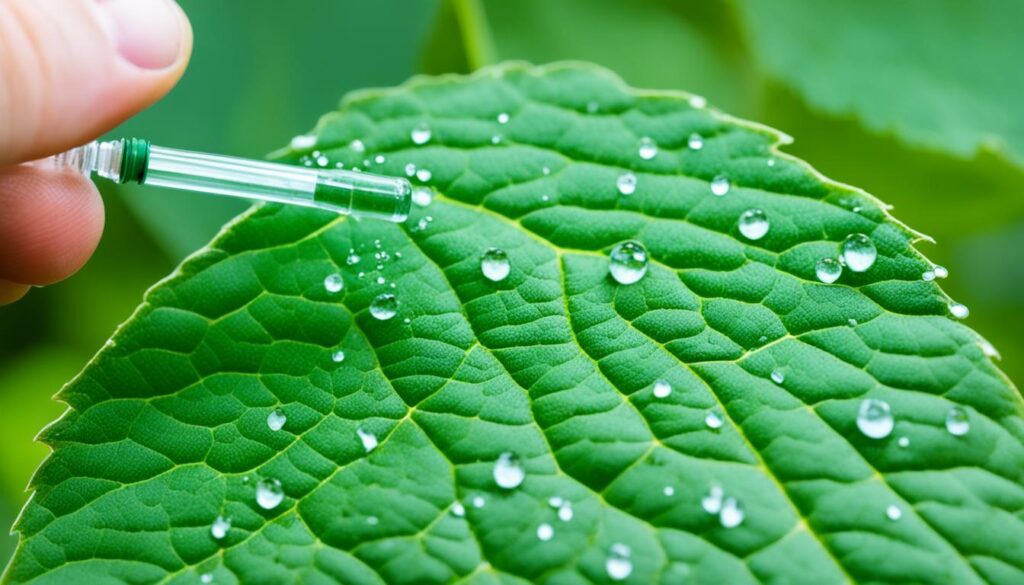
Conclusion
Learning about common indoor plant problems and how to fix them will help you keep your plants healthy. Watch your plants closely and change their environment if needed. Act fast if you see any issues. This way, your houseplants will stay healthy and make your home bright for a long time.
With the right knowledge and effort, you can keep your indoor plants looking great. Learn about common problems and fix them early to keep your plants healthy. A little expert advice can make your indoor garden beautiful and peaceful.
This guide has given you the tools to solve many indoor plant problems. Stay alert, adjust your plants’ environment, and treat them right to keep them thriving. Enjoy gardening indoors and let your plants make your home more beautiful.
FAQ
What are some common causes of yellowing leaves on indoor plants?
Yellow leaves can come from watering problems, not enough sunlight, or pests. Too much water makes lower or inner leaves turn yellow. Not enough water makes new leaves turn yellow. Too much or too little sunlight also causes yellowing leaves. Look for pests like thrips or spider mites and treat them.
Why are my indoor plants suddenly dropping leaves?
Plants drop leaves when they face sudden changes in their environment. Plants like Ficus don’t like sudden changes in light, temperature, or location. This can make them shed leaves. Overwatering can also cause leaf drop, as the plant tries to save resources. Watch how you water and move plants slowly to avoid losing too many leaves.
What causes discolored leaf tips or edges on indoor plants?
Discolored tips or edges can come from low humidity, salt buildup, or uneven watering. To increase humidity, mist the plants, use a pebble tray, or group them together. Clean the soil of salts by running water through it. Don’t fertilize during the plant’s dormant period. Repotting in fresh soil can also help. Some diseases can cause leaf curling or tip damage, so use neem oil fungicide if needed.
Why are my indoor plant’s leaves distorted or failing to unfurl properly?
Distorted leaves or new growth not unfolding right might mean pests or diseases. Check for thrips, aphids, or other bugs and treat with insecticidal soap or neem oil. Fungal diseases can also cause strange growth, so let leaves dry out during the day and use neem oil as a fungicide. Compacted or dry soil can make leaves curl or grow wrong, so refresh the soil and water properly.
What are the signs of inadequate lighting for indoor plants?
Weak, long growth and tiny flying bugs like fungus gnats show poor lighting. Plants stretch and grow unevenly as they seek more light. Rotating the plant, moving it to a brighter spot, or adding artificial light can help. Fungus gnats, whose larvae eat plant roots, come from overwatering. Let the soil dry out, then repot in fresh, well-draining soil to stop the pests.
How can I identify sap-sucking pests on my indoor plants?
A sticky or shiny residue on leaves and nearby surfaces means sap-sucking pests like mealybugs, scale, or aphids are present. Inspect the plant carefully, focusing on the underside of leaves and where leaves meet stems. Clean leaves with insecticidal soap or neem oil to get rid of the pests. Isolate the plant until the problem is fixed to stop spreading to other plants.
What are some signs of environmental stress in indoor plants?
Signs of stress include wilting, leaf color changes, and slow growth. These show the plant is struggling with its environment. Adjust watering, move the plant to a better spot, and increase humidity to help it recover. Salts and nutrient shortages can also stress plants, which can be fixed by flushing the soil and using balanced fertilizer.
How can I identify and treat pests and diseases affecting my indoor plants?
Look for pests like spider mites, scale, aphids, and mealybugs, and diseases like powdery mildew and root rot. Treat with insecticidal soaps, neem oil, or other specific remedies. For severe cases, stronger chemicals might be needed. Viral infections require removing the affected plant to protect others.


